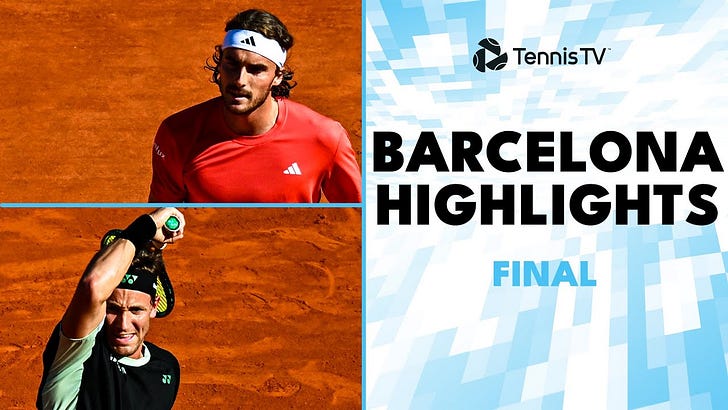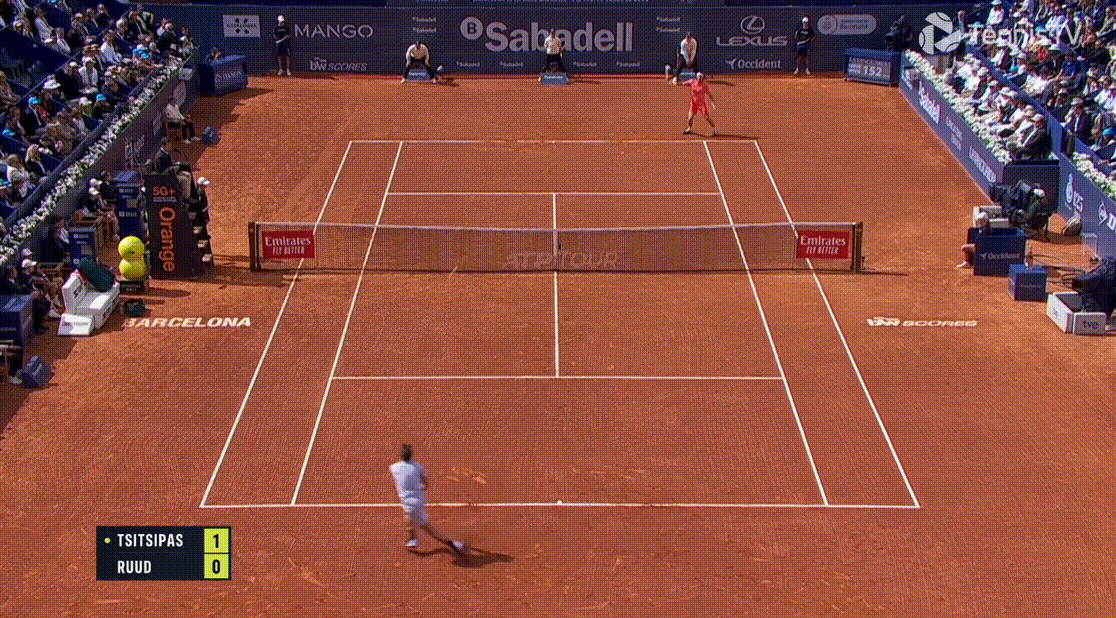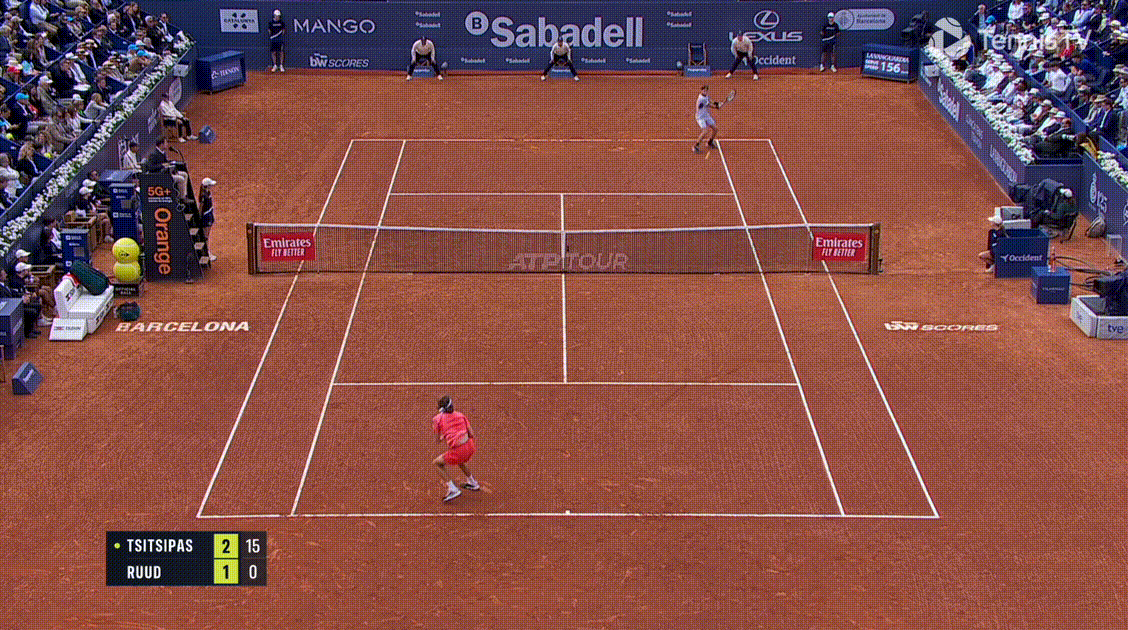Ruud vs Tsitsipas: Barcelona Final Recap
Return adjustments — peppering backhands — serve percentages
Casper Ruud defeated Stefanos Tsitsipas 7/5 6/3 in the final of the Barcelona ATP 500 on Sunday to earn his first 500 title. It was a case of swift revenge for Ruud, who lost last week’s Monte Carlo final to the Greek. Tsitsipas is now 0-11 in ATP 500 finals and trails Ruud 2-3 in their ATP H2H.
First Set
Ruud’s forehand failed to fire in Monte Carlo; he was both impatient and imprecise. Things didn’t start any better in Barcelona, as he was broken in the opening game with early misses from both wings on his +1 ball.
Although down early, Ruud made his intentions clear in his first return game, taking the ball up on the baseline in a bid to counter Tsitsipas’ dominating +1 forehand and serve-and-volley tactics that were a feature of his win in Monte Carlo.
Last week in Monte Carlo, Ruud failed to apply enough pressure on Tsitsipas’ serve from his usual deep return position. He couldn’t find the Greek’s backhand, nor apply pressure to the forehand. Furthermore, Tsitsipas serve-and-volleyed with great success. Late in that match Ruud adopted a more aggressive return position like the one shown above.
Look how many forehands Tsitsipas found from his backhand corner after the serve in Monte Carlo, largely due to Ruud’s deep return position:
While the tradeoff of taking the ball early is that you (likely) miss more, it makes it easier to find your opponent’s backhand. Furthermore, taking the ball early means that your opponent is in a weak position to defend having landed inside the baseline after their serve:
Tsitsipas didn’t have time to run around this return and was forced to hit a weak backhand while recovering backward. Ditto for the below return:
Ruud broke back at 2-3, courtesy of some loose play from Tsitsipas, but the trend through the first five games was encouraging for the Norwegian. His first-serve percentage was above 70%, and he was hitting his forehand with more authority. He was also finding the Greek’s backhand more often, which, despite Tsitsipas’ brilliant efforts off that wing in Monte Carlo, was experiencing a reversion to the mean.
The play against Tsitsipas will always be to apply pressure to the backhand.
A commentator revealed a damning stat from Tsitsipas’ Australian Open campaign during his 2023 Australian Open final loss to Djokovic:
“Whenever he [Tsitsipas] hits two backhands in a rally he wins just a third of the points.”
“That’s scary. Those are stats you don’t want to hear.”
The stat was largely holding throughout the first set in Barcelona. Of the 17 points where Ruud managed to find the Tsitsipas backhand twice in a rally, he won 10, leaving Tsitsipas with 41% of points won. It probably would have been worse if not for one interesting adjustment Tsitsipas made in this match, where he used the short slice/drop shot on his backhand to bring Ruud forward to great effect.
Ruud is split-stepping back as Tsitsipas plays this short backhand slice crosscourt. It’s a great play to force a two-hander to take their left hand off the racquet and engage in some cat-and-mouse. Tsitsipas used this short slice four times in the first set successfully.
Despite these adjustments from both, what broke open the first set (and the match) was Ruud’s backhand down-the-line catching fire at 6-5. Far from being the strength of his game, an open-stance sliding backhand provided the opening:
I can’t recall many prior instances of Ruud hitting this shot.
Tsitsipas went to the serve-and-volley tactic the very next point after seeing Ruud drop back on the second serve. This play had served him so well last week. This time, Ruud found the line for the two-shot pass:

Ruud took his first chance at 15-40, carving a backhand slice passing shot down the line that Dan Evans would be proud of. Tsitsipas dumped it into the net.
I touched on the defensive slice when your opponent is coming forward in the Alcaraz/Medvedev final from Indian Wells last month. There’s a lot of perks if you can play it: It’s harder to volley a slow, low, backspinning ball; Ruud can play the ball later/further behind him compared to his double-hander even; you can land it shorter more easily than a topspin or flat shot; and it buys Ruud more time to recover and get to the next ball.
Second Set
Ruud opened strongly in the second set, keeping his first-serve percentage high and finding Tsitsipas’ backhand off the ground with his own heavy forehand. I’d been tracking a metric of how many times Ruud found the Tsitsipas backhand not twice at any point in a given rally, but three times in a row in a rally. It had happened 5 times through 7-5 1-0, and Ruud had won all five. Tsitsipas won the sixth, having to come up with this:
Three Ruud forehands into three Tsitsipas backhands. If they play this point 10 times, Ruud wins nine.
Tsitsipas also won the seventh of this version; a long, drawn out rally at 3-1 that ended with Ruud missing his backhand crosscourt long. Tsitsipas had done well, absorbing six blows to the backhand in that rally, and the error from Ruud must have been a weight off his shoulders.
But look what happened on the very next serve, where Ruud opted to kick his first-serve high into the Tsitsipas backhand once more. Tap out. No mas.1
That’s missed by metres. It reminded me of Tsitsipas bailing out of the backhand in last year’s Barcelona Final against Alcaraz.
It’s not easy to find Tsitsipas’ backhand consistently; you have to bring a mix of firepower and discipline to keep him pegged there, but if you can do it, the returns compound across multiple points.
Ruud could smell blood. Here he goes again two points later. This backhand from Stef barely gets half way up the net.
Ruud would finish with 7/9 points won when forcing Tsitsipas to hit three backhands in a row. The two points he lost he had a clear advantage in.2
Did Tsitsipas try to do the same? Not really. He often opted to try and rush the Ruud forehand when he had the chance. I can understand why. Stef’s crosscourt forehand is one of the best in the business, and Ruud isn’t as good on the forehand when rushed or defending. But of the four points where Tsitsipas did hit three shots into Ruud’s backhand, he won all four.
There’s something about keeping it simple and peppering the backhand on clay when your opponent’s weaker side is the backhand.
Some Spaniard used to do that to some Swiss guy to good effect. Anyway, a look at the rap sheet.

If I had to summarise what Ruud did better today compared to their Monte Carlo match, it would be:
Played more patiently with the forehand. In Monte Carlo Ruud was too impatient and tried to hurt the Tsitsipas forehand early in the rally. Here he took big cuts at the ball, but was often willing to to hit 2, 3, sometimes 4 forehands in a row to the Tsitsipas backhand.
Took his backhand down the line more often. Ruud took his backhand down the line successfully last week in Monte Carlo as well, but he took it up a notch in Barcelona.
Committed to the aggressive return position.
Made 80% of first serves today. Up from 65% in Monte Carlo.
Interestingly, Tennis Insights had Ruud performing worse with his backhand and serve today compared to Monte Carlo.
Maybe my eyes deceive me, or maybe I am recalling how often Ruud came up with big backhands in important moments (does Tennis Insights account for this? Not all points are equal in tennis). Ruud clutch backhands:
backhand crosscourt passing shot at 30-40 2-3 to get back on serve
backhand down the line serving at 15-30 3-3
backhand down the line at 15-30 at 5-5
backhand down the line passing shot winner at 15-15 6-5
backhand down the line 2-shot passing shot at 15-30 6-5
That was just the first set. You get the idea.
It’s only fair to point out that Tsitsipas looked fatigued today as well. He had multiple three-setters in his quarterfinal and semifinal matches, and his movement and overall execution just wasn’t as sharp today as it was in Monte Carlo.
If we get a third meeting on the clay between these two, I’d love Monte Carlo Stef to play Barcelona Casper. Now that would be a match.
Ruud is now back up to #6 in the rankings as we get deeper into the clay swing. He has form, momentum, and confidence, as does his opponent from today, who is back up to #7.
I forgot to post this in the original submission, but for those interested, I participated in one of Gill Gross’ mailbag episodes on his Monday Match Analysis podcast last week. Gill does a fantastic job breaking down finals that you can listen to on YouTube or your favourite podcast app. We had a blast, and I’m sure we will do it again some time in the future.
Madrid gets underway on the 24th. I’ll try and drop a draw preview if time permits.
See you in the comments. HC
A similar pattern occurred in Tsitsipas’ semifinal win over Sinner at Monte Carlo. Sinner found the Tsitsipas backhand 3x in a row on 9 of his service points. On the next Sinner serve point, Tsitsipas missed 7/9 returns. See here for more.
Even in Tsitsipas’ impressive backhand performance from the Monte Carlo final, Ruud won 4/7 when going into the Greek’s backhand three times in a row.
















Great post as always!! Stef is one of the few who almost never slices. I really think he could mix a little more just to give himself time. I also think he was looking fatigued and fought to just get to the final. I really hope he takes a break at some point or loses early before RG. He has a shot of winning it this year. The problem is that he will have to be playing at the top of his game to do so.
Among the 4 semi-finalists in Barca, Carlos has a 13-0 record against them. He's never played Etcheverry. 9-0 against Ruud/Tsitsipas. Very different tournament if he's in it.